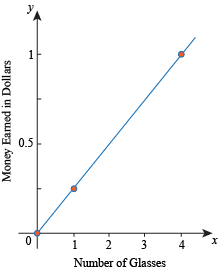Lots of word problems can be solved with systems of linear equations. However, before we bother with those, let's look at some word problems that describe single lines, and we're not referring to orderly rows of petrified eighth graders on their way into a school dance.
Going from Words to a Linear Equation
The hardest part of word problems is usually translating from English into math, so we'll practice that part first.
Sample Problem
Write and graph the linear equation described by the following statement:
Jenna works at a retail shop. She makes $10 per hour, plus $3 for each item she sells.
The amount Jenna makes depends on how many items she sells, so our independent variable x should be the number of items she sells, and the dependent variable y should be the amount she's paid. On the graph, the horizontal axis will represent the number of items Jenna sells during one hour, and the vertical axis will represent the amount she gets paid during that hour. By the way, $3 is quite a commission rate, considering that most of the shop's inventory consists of cheap polyester scarves that sell for $10 a pop. Her dad must run the place.

Since Jenna is paid $10 if she sells 0 items, the point (0, 10) will be on the graph. If Jenna sells 1 item she's paid $13, and if she sells 2 items she's paid $16, so the points (1, 13) and (2, 16) are also on the graph:

Now we can connect the dots with a line:

Since it doesn't make sense to have Jenna sell a negative number of items, we only draw the part of the line where x is at least 0. We aren't accounting for the dozens of scarves that Jenna has been sneaking into her bag for herself, in which case she is practically selling a negative number of them, but in the interest of simplicity, let's look the other way and pretend we saw nothing.
From the graph, we can now write an equation for this line in slope-intercept form. The y-intercept is 10, and the slope is 3, so the equation we want is
y = 3x + 10.
If we want to be fussy, we can also write down the condition
x ≥ 0.
Whenever we're writing an equation for a word problem, we need to specify what the variables are.
Sample Problem
Write and graph the linear equation described by the following statement:
Lukas left his house at noon to go for a drive. He drove at a constant speed. In fact, it was so constant we're not entirely convinced he didn't just set a brick on the accelerator, then recline his seat and take a nap. Anyway, Lukas was 200 miles from home at 3 p.m.
Lukas's distance from home depends on how long he's been driving. Let's have x be the number of hours Lukas has been driving, and
y be Lukas's distance from home.
The graph set-up will look like this:

Since Lukas left from his house, he was 0 miles from his house after 0 hours of driving, so the point (0, 0) is on the graph. After 3 hours of driving, Lukas was 200 miles from his house, so the point (3, 200) is also on the graph. We wonder if all this algebra-talk is distracting Lukas from how homesick he's feeling right about now.

Now we connect the dots to make a line:

As for the equation, we can see that the slope of the line is
 .
.
Since the y-intercept is 0, the equation of the line is
 .
.
Again, notice that we only graphed half of the line. It doesn't make sense to think about Lukas driving for a negative number of hours, so we leave that part out. He may be speedy, but he's not quite speedy enough to turn back time. No matter how much Cher wishes he could.
Example 1
For the following situation,
Bobby has a lemonade stand and charges 25 cents for each glass of lemonade. Don't tell anyone, but he cuts the lemonade with |
Example 2
For the following situation,
Joe lives 20 miles to the east of a very nice park. He left his home at 1 p.m. and drove east for 3 hours. When he stopped, he was 206 miles away from the park. The birds had finally stopped following him. |
Example 3
For the following situation,
Aunt Marjie doesn't like going outside in the cold. Seriously...she's a big baby about it. If it's -10° F she'll only stay outside for 2 minutes, but if it's 70° F she'll stay out for 2 hours. Even at 70° though, she's still complaining. |
 water to increase his profit margin. Did someone teach this kid right or what?
water to increase his profit margin. Did someone teach this kid right or what?

 th of an hour.)
th of an hour.)
 or any equivalent equation.
or any equivalent equation.